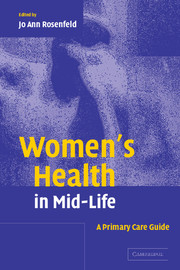Book contents
- Frontmatter
- Contents
- List of contributors
- 1 Introduction
- Part I Health promotion
- Part II Hormonal changes
- 8 Physical changes in menopause and perimenopause
- 9 Spiritual and psychological aspects of menopause
- 10 Hormone therapy
- 11 Contraception and fertility
- Part III Disease prevention
- Part IV Cancer prevention
- Index
- References
10 - Hormone therapy
from Part II - Hormonal changes
Published online by Cambridge University Press: 21 August 2009
- Frontmatter
- Contents
- List of contributors
- 1 Introduction
- Part I Health promotion
- Part II Hormonal changes
- 8 Physical changes in menopause and perimenopause
- 9 Spiritual and psychological aspects of menopause
- 10 Hormone therapy
- 11 Contraception and fertility
- Part III Disease prevention
- Part IV Cancer prevention
- Index
- References
Summary
Case: a 51-year-old healthy woman presents to the office. She has two children, 24 and 21 years of age, both delivered by cesarean section for fetal distress. Following the second delivery, she had a bilateral tubal ligation for contraception. She has had no other medical conditions. She reports that her menses have changed over the past year, becoming shorter and lighter. She occasionally skips a period altogether. She reports hot flushes, palpitations, and some sleep disruption. She believes that the sleep disruption has led to fatigue and some mild cognitive changes, which are beginning to interfere with her work performance. She has no personal or family history of breast cancer, coronary artery disease, or thromboembolic disease. She does have a family history of osteoporosis. She is a non-smoker, drinks two beers weekly, and exercises inconsistently. Her best friend had been on hormone therapy but stopped with the recent news concerning adverse effects. She wants to know whether she should consider hormonal therapy for her hot flushes and sleeping difficulty or if there is anything “safer.”
Introduction
Hormone therapy (HT) is the combined use of estrogen and progestin (EPT), or estrogen alone (ET), by postmenopausal or perimenopausal women. The US Food and Drug Administration (FDA) Office of Drug Evaluation has recently substituted the term “hormone therapy” for “hormone replacement therapy” to highlight the fact that postmenopausal hormones are treatment for certain conditions, not a necessary replacement for hormones that decrease as part of the normal menopause.
Keywords
- Type
- Chapter
- Information
- Women's Health in Mid-LifeA Primary Care Guide, pp. 151 - 190Publisher: Cambridge University PressPrint publication year: 2004



